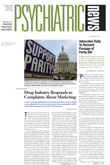Thomas William Salmon, M.D. (1876-1927), was in charge of psychiatry for the American Army overseas during World War I. He became medical director of the National Committee for Mental Hygiene (now the National Mental Health Association) in 1915. With World War I under way in Europe, the organization had begun to collect information about psychiatric casualties and their management. Also, an earlier survey of American Army troops had found a higher number of psychiatric cases than in the civilian population.
In early 1917 Salmon, with Dr. Pearce Bailey, a New York neurologist who later worked in the Army surgeon general’s office, and Dr. Stewart Paton of Princeton, N.J., headed the preparation of a neuropsychiatric service plan for the Army. Salmon also went to Great Britain to study how that country was managing psychiatric casualties. When the United States entered the war, Salmon was named senior psychiatrist for the Army overseas. The plan had included the screening of inductees and establishment of base hospitals and 30-bed units in general hospitals for psychiatric patients. Most important was the designation of division consultants who were senior psychiatrists.
The term “shell shock” had come into popular use by this time but was rejected by Army personnel in favor of the term “war neurosis.” Dr. Edward Strecker, a division consultant, wrote that the condition resulted from operation of defensive mechanisms based on the instinct of self-preservation.
The proposed plan, put into operation by Salmon, worked as intended. Soldiers evacuated because of psychiatric symptoms were treated as close to the front as possible with rest, nutrition, occupational therapy, and recreation. The staff and therapeutic atmosphere reinforced the expectation that these soldiers would return to their units for further duty. Psychotic patients were sent home to the United States. (Unfortunately, the success of the World War I plan was forgotten and had to be rediscovered during World War II.)
After the war ended in 1918, Salmon returned to the United States with much concern for the continuous care of veterans with psychiatric conditions. The Bureau of War Risk Insurance and the Public Health Service (PHS) were the responsible agencies. Existing PHS hospitals were first used, with the addition of new facilities, and the overflow was directed to public and private mental hospitals. Salmon found these arrangements unsatisfactory because of conflicting policies and staff limitations among Army and Navy agencies.
In 1919 the surgeon general of the PHS invited Salmon and four other outstanding neuropsychiatrists to develop a plan for hospitalized veterans who were diagnosed as mental and neurosis cases. The final report recommended special veterans hospitals.
The Harding administration, which came into office in 1921, rejected the report, claiming that no additional beds were needed. Salmon tackled the rejection head on, enlisting the aid of the American Legion and other organizations. Spokespersons for the American Legion later declared that Salmon was the greatest single factor in getting medical help for disabled veterans.
That same year, Congress established the Veterans Bureau to consolidate agency efforts, but a corrupt director, Dr. C. R. Forbes, ignored the psychiatrists’ recommendations (he later went to federal prison for misusing federal funds). It was some years before the Veterans Bureau was able to become an efficient organization.
Salmon left his imprint on the practice of military psychiatry, and his memory lives on through the annual Salmon Lecture and Medal sponsored by the New York Academy of Medicine. ▪
